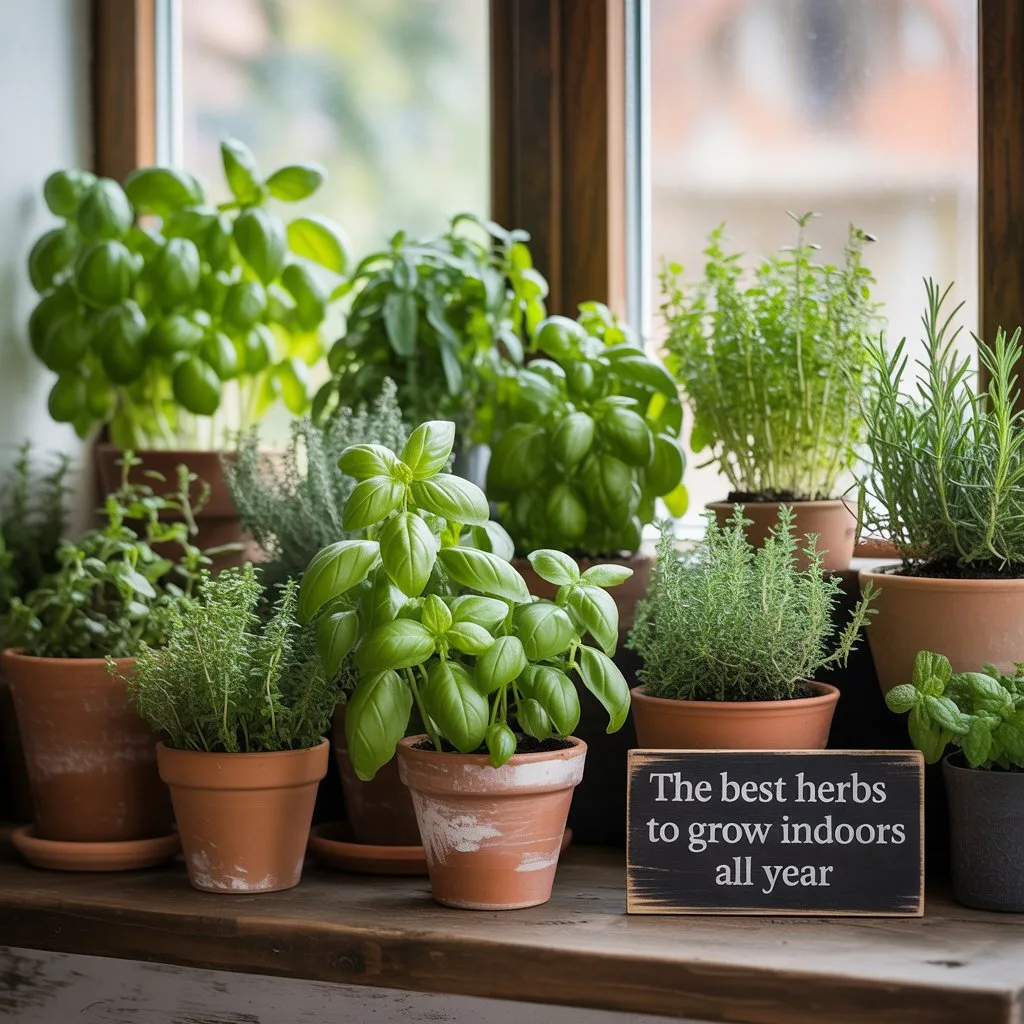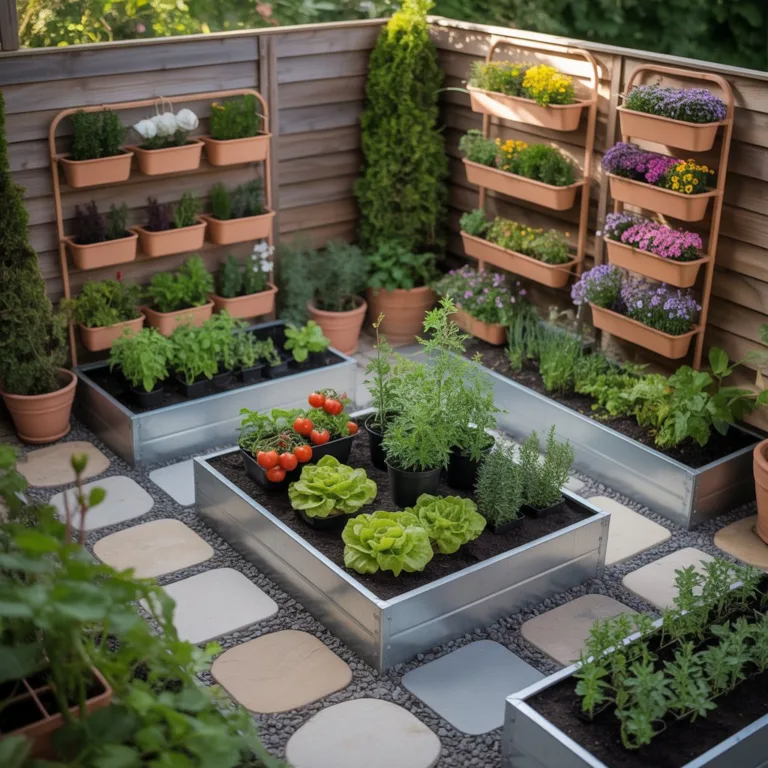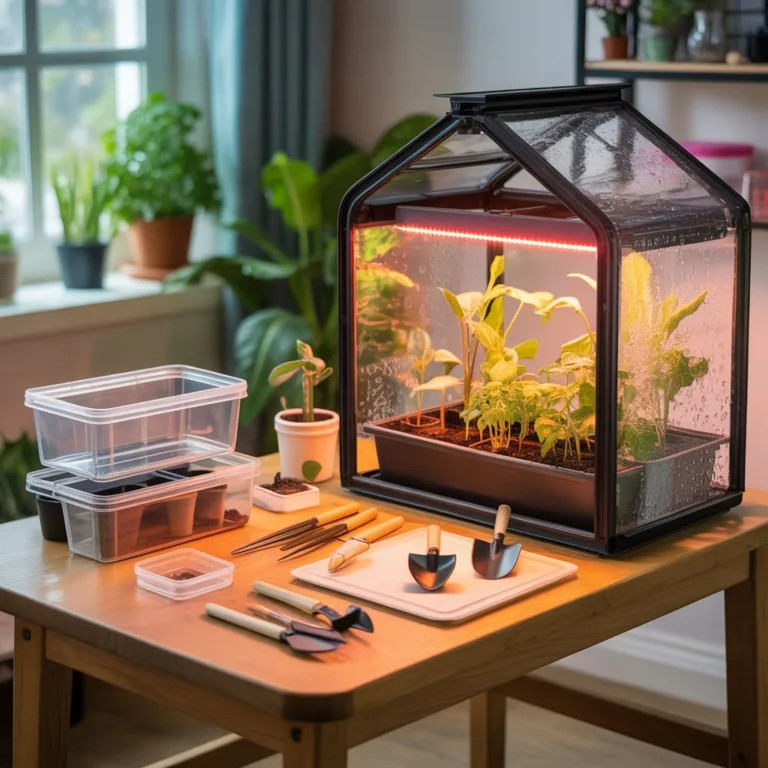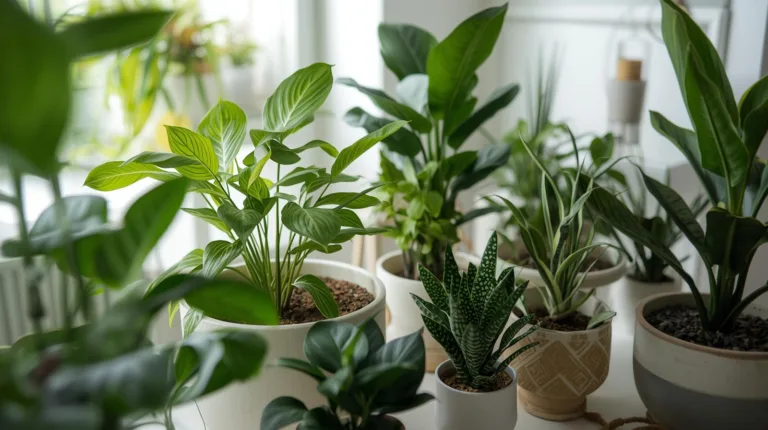Growing herbs indoors is one of the most rewarding and practical ways to bring freshness, fragrance, and flavor into your home all year long. Whether you live in a small apartment or a house with limited outdoor space, an indoor herb garden can transform your cooking, enhance your décor, and improve your well-being.

The beauty of growing herbs indoors lies in their simplicity—they require minimal space, thrive in containers, and can flourish on a sunny windowsill or under a grow light. With just a few essentials like sunlight, good soil, and consistent watering, you can enjoy a continuous supply of culinary herbs right at your fingertips.
This guide explores the best herbs to grow indoors throughout the year, including how to care for each one, the best growing conditions, and creative ways to use them in your daily life.
Why Growing Herbs Indoors Is a Smart Choice
Indoor herb gardening offers more than just fresh ingredients. It also connects you with nature, adds greenery to your living space, and provides a calming, sensory experience.
Here are some reasons why it’s worth growing herbs indoors all year:
- Fresh flavor anytime: You’ll never run out of your favorite seasonings.
- Lower grocery costs: Fresh herbs can be expensive in stores, especially out of season.
- Cleaner indoor air: Many herbs purify the air and release pleasant aromas.
- Compact and flexible: Herbs fit into small spaces—windowsills, countertops, or even wall planters.
- Therapeutic and rewarding: Watching plants grow and harvesting your own herbs brings relaxation and satisfaction.
Key Tips for Successful Indoor Herb Gardening
Before diving into the best herbs to grow indoors, it helps to understand the fundamentals of caring for them.
Lighting Matters Most
Most herbs need at least 6 hours of sunlight daily. South-facing windows are ideal, but if natural light is limited, use LED grow lights to simulate sunlight.
Choose the Right Containers
Select pots with good drainage holes to prevent waterlogging. Herbs like basil, thyme, and oregano prefer slightly dry conditions, so well-draining soil is essential.
Water Wisely
Overwatering is the most common mistake. Let the top inch of soil dry before watering again. Consistent but moderate moisture keeps roots healthy.
Trim Regularly
Frequent trimming encourages new growth. Harvest herbs by cutting just above leaf nodes to promote fuller, bushier plants.
Fertilize Occasionally
A light feeding every 4–6 weeks with an organic liquid fertilizer supports healthy growth without overwhelming your plants.
The Best Herbs to Grow Indoors All Year
Each herb has unique growing preferences, but many adapt beautifully to indoor environments. Below are some of the best and easiest options to cultivate indoors, along with care tips and culinary uses.
Basil
Why It’s Great:
Basil is a staple for indoor gardens and brings vibrant flavor to a wide range of dishes. Its bright green leaves and aromatic scent make it a kitchen favorite.
Growing Tips:
- Prefers warmth and bright light—6 to 8 hours daily.
- Keep soil slightly moist but not soggy.
- Pinch off flower buds to encourage more leaf growth.
Culinary Uses:
Use fresh basil for pesto, tomato sauces, pizzas, salads, or infused oils. Combine with mozzarella and tomatoes for a refreshing Caprese salad.
Mint
Why It’s Great:
Mint is one of the easiest herbs to grow indoors and adds freshness to both sweet and savory recipes. It also gives off a pleasant aroma that deters pests.
Growing Tips:
- Thrives in indirect sunlight.
- Keep soil consistently moist.
- Mint spreads quickly—grow it in a separate pot to prevent crowding.
Culinary Uses:
Perfect for teas, lemonades, cocktails like mojitos, or desserts. Fresh mint also complements lamb, salads, and yogurt-based dishes.
Rosemary
Why It’s Great:
Rosemary adds both fragrance and flavor to any indoor garden. Its woody stems and needle-like leaves release a strong, refreshing aroma.
Growing Tips:
- Prefers bright light and slightly dry soil.
- Allow the top inch of soil to dry before watering again.
- Rotate the pot occasionally for even growth.
Culinary Uses:
Use rosemary in roasted meats, potatoes, breads, and soups. It also pairs beautifully with garlic and olive oil.
Thyme
Why It’s Great:
Thyme is hardy and tolerant of neglect, making it perfect for beginners. It’s a small, low-growing herb that fits easily on any windowsill.
Growing Tips:
- Needs bright light and well-drained soil.
- Avoid overwatering; thyme prefers drier conditions.
- Trim regularly to encourage new growth.
Culinary Uses:
Excellent for seasoning meats, vegetables, and sauces. Thyme adds depth to soups and stews and pairs well with lemon and garlic.
Parsley
Why It’s Great:
Parsley is both decorative and versatile. Its curly or flat leaves are packed with vitamins and enhance the presentation of any dish.
Growing Tips:
- Grows best in bright indirect light.
- Keep soil moist but not soggy.
- Harvest outer leaves first to allow new growth from the center.
Culinary Uses:
Use parsley as a garnish, in tabbouleh, or to brighten pasta, soups, and salads. It blends well with garlic, lemon, and olive oil.
Chives
Why It’s Great:
Chives are fast-growing, easy to maintain, and add a mild onion-like flavor to foods. Their slender green shoots also look attractive indoors.
Growing Tips:
- Enjoy bright light and well-draining soil.
- Water regularly to keep soil lightly moist.
- Trim leaves frequently to stimulate growth.
Culinary Uses:
Ideal for sprinkling on eggs, potatoes, soups, and dips. Chives add color and a subtle bite to creamy dishes.
Oregano
Why It’s Great:
A favorite in Mediterranean cooking, oregano offers a robust, earthy flavor. It’s drought-tolerant and thrives in bright, warm spots.
Growing Tips:
- Requires strong sunlight or supplemental grow light.
- Let soil dry between watering sessions.
- Harvest leaves once the plant reaches several inches in height.
Culinary Uses:
Essential for pizza sauces, pasta dishes, and marinades. Oregano complements tomatoes, meats, and grilled vegetables perfectly.
Cilantro (Coriander)
Why It’s Great:
Cilantro provides a unique, citrusy flavor that enhances many cuisines. Though it has a short growing cycle, you can plant seeds successively for a continuous harvest.
Growing Tips:
- Needs cooler temperatures and indirect light.
- Water frequently but ensure proper drainage.
- Harvest leaves when they are young and tender.
Culinary Uses:
Common in Mexican, Indian, and Asian dishes. Use cilantro in salsas, curries, soups, or as a garnish for tacos and salads.
Sage
Why It’s Great:
Sage is a resilient herb with soft, gray-green leaves and a rich, earthy aroma. It’s both ornamental and flavorful.
Growing Tips:
- Requires 6–8 hours of sunlight.
- Allow soil to dry out between waterings.
- Avoid overfertilizing; sage thrives in lean conditions.
Culinary Uses:
Adds depth to roasted meats, stuffing, and creamy pasta dishes. Sage pairs beautifully with butter and poultry.
Lemongrass
Why It’s Great:
Lemongrass brings a zesty, citrus aroma to your home and culinary creations. It grows tall and elegant, adding an exotic touch to your indoor garden.
Growing Tips:
- Needs bright, warm conditions.
- Keep soil consistently moist.
- Harvest by cutting stalks near the base once mature.
Culinary Uses:
Essential in Thai and Vietnamese cooking. Use lemongrass for soups, teas, and marinades.
Bay Laurel (Bay Leaf)
Why It’s Great:
Bay laurel is a slow-growing perennial herb that thrives indoors with care. Its glossy leaves are aromatic and essential for stews and sauces.
Growing Tips:
- Prefers bright, indirect light.
- Allow the soil surface to dry before watering.
- Prune regularly to maintain a compact shape.
Culinary Uses:
Used whole in soups, stews, and sauces. Bay leaves add subtle depth to long-simmered dishes.
Setting Up the Perfect Indoor Herb Garden
Creating an indoor herb garden doesn’t require much space or equipment. Here’s how to set up a thriving year-round growing area:
- Select the right location: Choose a sunny windowsill or a spot near a light source.
- Use quality potting mix: A mix designed for indoor plants ensures proper drainage and nutrition.
- Group herbs with similar needs: For example, basil and parsley like moisture, while thyme and rosemary prefer drier soil.
- Label your pots: Especially useful if you’re growing multiple herbs at once.
- Keep air flowing: Gentle air circulation prevents mildew and mold growth.
For those with limited sunlight, compact grow lights make a great alternative. They can extend growing hours during winter and keep herbs lush and productive.
Creative Ways to Use Your Fresh Herbs
Once your indoor garden is thriving, you’ll find endless ways to use your harvest beyond just cooking.
Herbal Infused Oils and Vinegars
Create custom blends by steeping herbs like rosemary, thyme, or basil in olive oil or vinegar for unique flavors.
Homemade Herbal Teas
Mint, lemon balm, and chamomile make soothing teas perfect for relaxation.
Natural Air Fresheners
Bundle herbs like lavender and rosemary for natural fragrance around the home.
DIY Bath and Beauty Products
Add herbs to bath salts, scrubs, or soaps for a touch of nature in your self-care routine.
Gifts from the Garden
Potted herbs make thoughtful, sustainable gifts for friends and family.
Maintaining Herbs Through All Seasons
Indoor environments change with the seasons, so herbs may require adjustments throughout the year.
Winter: Reduce watering and provide extra light with grow lamps.
Spring: Fertilize lightly to encourage fresh growth.
Summer: Watch for overheating near windows and rotate pots for even sunlight.
Autumn: Trim and harvest regularly to prevent legginess.
By observing your plants and adjusting care routines, you can ensure they thrive no matter the season.
Bringing Nature Indoors Year-Round
Growing herbs indoors all year long connects you to nature in the most delightful way. Every time you trim a sprig of rosemary or pinch fresh basil leaves, you experience the rewards of patience, care, and creativity.
With the right conditions and consistent attention, your indoor herb garden will not only supply fresh ingredients but also bring a sense of peace and accomplishment. Start small with a few favorite herbs, nurture them, and watch your green oasis flourish right inside your home.

Sofia Greenfield is a sustainable gardening expert and environmental educator who inspires families and urban gardeners to cultivate green spaces responsibly. She shares practical tips on growing vegetables, herbs, and flowers using eco-friendly and recycled materials, emphasizing the joy of gardening while protecting the planet.



